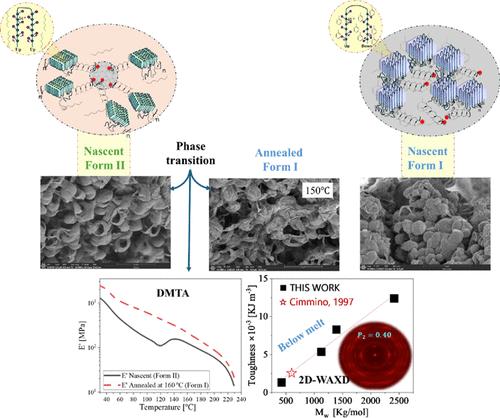具有新生单晶形态的超高分子量等规聚(4-甲基戊烯-1)的多尺度控制:从分子合成到宏观性质
IF 5.2
1区 化学
Q1 POLYMER SCIENCE
引用次数: 0
摘要
等规聚(4-甲基-1-戊烯)(iP4MP1)是一种以其高透明度和透气性而闻名的独特材料。iP4MP1具有很高的热稳定性和化学稳定性,使其适用于各种应用。我们研究了聚合介质对聚合产物的形态和力学性能的影响。在正庚烷和甲苯的混合物中采用芳基吡啶酰胺铪催化剂,获得了具有单峰分布的超高分子量UHMW-iP4MP1。使用正庚烷作为聚合溶剂,iP4MP1链的混溶性较差,形成亚稳的单斜型II型晶体,熔化后转变为稳定的四方型i型晶体。研究表明,聚合过程中的结晶动力学可以调整,以合成单晶状iP4MP1。低纠缠的单晶状iP4MP1可以在熔化温度以下进行单轴变形,促进链排列。与iP4MP的立体特异性一致,流变学分析表明缠结之间的分子量很高(Me≈26,000 g/mol)。合成聚合物的机械性能,包括抗拉强度、断裂伸长率和韧性,随着分子量的增加而增加,突出了实现高级应用所需的均匀机械性能的潜力。本文章由计算机程序翻译,如有差异,请以英文原文为准。

Multiscale Control of Ultrahigh-Molecular-Weight Isotactic Poly(4-methyl-pentene-1) with Nascent Single-Crystal-like Morphology: From Molecular Synthesis to Macroscopic Properties
Isotactic poly(4-methyl-1-pentene) (iP4MP1) is a unique material known for its high transparency and gas permeability. iP4MP1 possesses high thermal and chemical stabilities, making it suitable for a wide variety of applications. We investigate the influence of polymerization medium on the resulting polymorphs and mechanical properties. By employing an aryl pyridylamido hafnium catalyst in a mixture of n-heptane and toluene, ultrahigh-molecular-weight UHMW-iP4MP1 having a unimodal distribution is achieved. The use of n-heptane as the polymerization solvent, where iP4MP1 chains are poorly miscible, resulted in the formation of metastable monoclinic Form II crystals, which below melting transform into the stable tetragonal Form I. The study demonstrates that crystallization kinetics during polymerization can be tailored to synthesize single-crystal-like iP4MP1. The low-entangled single-crystal-like iP4MP1 enables uniaxial deformation below the melting temperature, facilitating chain alignment. Consistent with the stereospecific nature of iP4MP, rheological analysis suggests high molecular weight between entanglements (Me ≈ 26,000 g/mol). Mechanical properties of the synthesized polymers, including tensile strength, elongation at break, and toughness, increase with the molecular weight, highlighting the potential for achieving uniform mechanical properties required for advanced applications.
求助全文
通过发布文献求助,成功后即可免费获取论文全文。
去求助
来源期刊

Macromolecules
工程技术-高分子科学
CiteScore
9.30
自引率
16.40%
发文量
942
审稿时长
2 months
期刊介绍:
Macromolecules publishes original, fundamental, and impactful research on all aspects of polymer science. Topics of interest include synthesis (e.g., controlled polymerizations, polymerization catalysis, post polymerization modification, new monomer structures and polymer architectures, and polymerization mechanisms/kinetics analysis); phase behavior, thermodynamics, dynamic, and ordering/disordering phenomena (e.g., self-assembly, gelation, crystallization, solution/melt/solid-state characteristics); structure and properties (e.g., mechanical and rheological properties, surface/interfacial characteristics, electronic and transport properties); new state of the art characterization (e.g., spectroscopy, scattering, microscopy, rheology), simulation (e.g., Monte Carlo, molecular dynamics, multi-scale/coarse-grained modeling), and theoretical methods. Renewable/sustainable polymers, polymer networks, responsive polymers, electro-, magneto- and opto-active macromolecules, inorganic polymers, charge-transporting polymers (ion-containing, semiconducting, and conducting), nanostructured polymers, and polymer composites are also of interest. Typical papers published in Macromolecules showcase important and innovative concepts, experimental methods/observations, and theoretical/computational approaches that demonstrate a fundamental advance in the understanding of polymers.
 求助内容:
求助内容: 应助结果提醒方式:
应助结果提醒方式:


